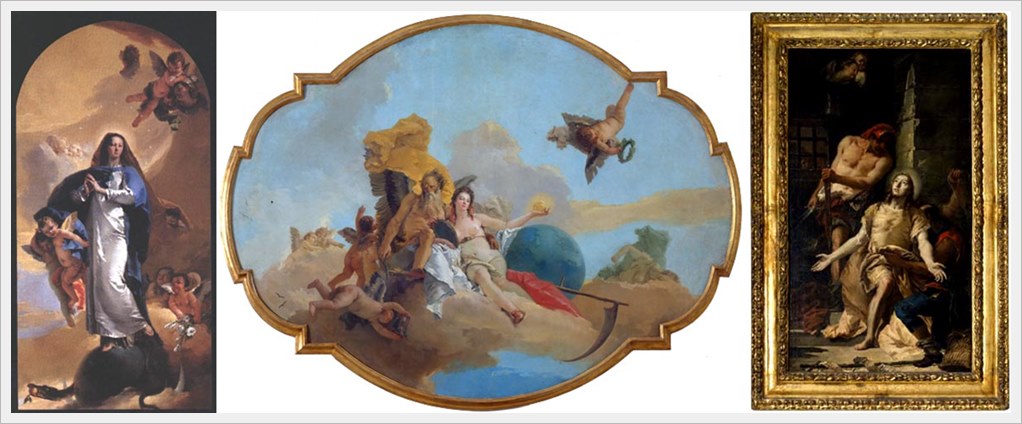Tiepolo
THE "VILLE TIEPOLESCHE" (tiepolesque villas)
 The expression "Ville Tiepolesche" gathers those villas in which Gianbattista Tiepolo worked in Vicenza's province, leaving various frescos and paintings. In 1734 he frescoed the interiors of Villa Loschi at Biron in Monteviale; in 1743 worked at villa Cordellina. In 1757 he transformed a modest architectural construction into that famous art masterpiece which is now best known as villa Valmarana ai Nani. His artistic contribution in these villas is so remarkable that they are nowadays more famous for his frescos than for their architectural value. Tiepolo's contributions to the Palladian villas represents the changing of his age: he lived and worked between the Renaissance and the Enlightenment. According to Palladio the villa was the centre of the agricultural life; on the other hand Tiepolo's villa becomes a prestigious residence, place for freedom and liberty unlike citylife.
The expression "Ville Tiepolesche" gathers those villas in which Gianbattista Tiepolo worked in Vicenza's province, leaving various frescos and paintings. In 1734 he frescoed the interiors of Villa Loschi at Biron in Monteviale; in 1743 worked at villa Cordellina. In 1757 he transformed a modest architectural construction into that famous art masterpiece which is now best known as villa Valmarana ai Nani. His artistic contribution in these villas is so remarkable that they are nowadays more famous for his frescos than for their architectural value. Tiepolo's contributions to the Palladian villas represents the changing of his age: he lived and worked between the Renaissance and the Enlightenment. According to Palladio the villa was the centre of the agricultural life; on the other hand Tiepolo's villa becomes a prestigious residence, place for freedom and liberty unlike citylife.
VISITS TO THE VILLE TIEPOLESCHE
Villa Valmarana ai nani
Vicenza - 2 km from the historic center in direction of the ss 247 Riviera Berica
Via dei Nani - tel. 0444 321803 https://www.villavalmarana.com/en/
Villa Cordellina Lombardi
Montecchio Maggiore - 11 km. from Vicenza s.s. 11 towards Verona
Via Lovara, 36 - tel. 0444 696085 - 0444 908214 https://www.provincia.vicenza.it/villa-cordellina-lombardi
Villa Loschi Zileri Dal Verme
Monteviale - localita' Biron - 4 Km from the historic center
Via Zileri, 1 - tel. 0444 964190 https://www.villazileri.com/en/index.html
TIEPOLO: THE SPREAD MUSEUM
CHIESA DI S.STEFANO (St. Steven's church) - Vicenza historic center
In this church the tabernacle of the high altar is adorned with three painting s by Giandomenico Tiepolo. They probably date back to the years 1758/60. The pictures in golden monochrome represent "S. Pierto", "S. Giovanni battista" and "La Resurrezione". The first two works can be ascribed to Giandomenico, whereas the third and part iculary the picture showing the soldiers hit by the divine light are his father's creation.
CHIESA DEI SS. VITO, MODESTO e CRESCENZIA (Church if ss. Vito, Modesto and Crescenzia) - Noventa Vicentina
The eighteenth century church of Noventa Vicentina is adorned with the altar-piece dedicated to "S. Rocco e S. Sebastiano" placed on a side altar. This oil-painting dates back to the years 1758/60. The realism of the paralytic old woman is opposed to the figures of the two saints: the wounded Sebastian bound to the tree is looking at the invalid, whereas Rocco is standing and looking upwards, towards the Heaven.
CHIESA DI SANTA MARIA MADDALENA (St. Mary Magdalene's church) - Rampazzo (Camisano Vicentino)
The paintings representing "the Apotheosis of St. Gaetano Thiene" is contemporaneous of the frescoes of Villa Valmarana (1757) and it was ordered by the Thiene family. The little church appearing in this painting reminds the working to built the parish church ordered by the same saint. St. Gaetano is reaching God lifted from the clouds. As remarked by Remo Schiavo, the artist prefers the "soft, light, rosy hues, as in the frescoes of Villa Valmarana punctually reminded by the silk clothes and the soft Puttos".
PALAZZO CHIERICATI - palace - Vicenza historic center
The works by the Tiepolo family kept in Civic Art Gallery are five: "L'immacolata concezione" and "Il Tempo che sopre la verita' " by Giambattista and "La Decollazione del Battista", “Enea e Anchise” and “Testa di Mercante” by Giandomenico.

"L’immacolata concezione" comes from the splendid church of Ara Coeli designed at the end of the Seventeenth century. This piece had adorned the Crucifix Altar until purchased by the Earl Barbieri in 1830. This painting, dating back to approximately 1735, shows all its magnificence in the silver dress and in the blue mantle of the Virgin Mary. The colour vary from a very light azure to dark blue. The red cloak of the angels at the right of the Virgin shades into yellow.
"La Verità svelata dal Tempo" was found in Palazzo Cordellina, located in Contrà Riale, right in the historic centre, even though it is believed it was once housed in Cordellina's villa in Montecchio Maggiore, as it is contemporary to the frescoes that decorate the villa (1743/44). Remo Schiavo states that this painting was placed on the ceiling of the pronaos, but this hypothesis is refuted by Fasolo and Puppi for the lack of a suitable place to hang the painting in the villa. The actual place of origin still remains unconfirmed. The picture is focused on the figure of the naked woman; as it is mentioned by Andreina Ballarin, she "almost cancels the rather gruesome zones of this Illuminist "moral", that is the "ancient" fleshes of the old man representing Time, the scythe, the hourglass, the hero's wreck".
"La Decollazione di San Giovanni Battista", attributed to Giambattista Tiepolo until 1910, was actually painted by Giandomenico. The emotional centre of the picture is the Saint's face enlightened by a divine light. The figure of the Baptist is opposed to that of the executioner and the darkness of the place increases the emotion.
“Aeneas and Anchises” was also mistakenly attributed to Giambattista; Giandomenico regained the authorship of the work in 1953, thanks to the studies of Giuseppe Fiocco. This painting recalls the left section of a sketch preserved in Helsinki and entitled “The Greek assault Troy on fire”: the character of Aeneas, tightening his grip on the Penates, carries his father Anchises on the shoulders while holding his son Ascanium by the hand, recognisable at the bottom of the composition.
“Testa di Mercante” belongs to the portrait category and, in particular, to a series of canvas with similar subjects and dimensions painted by the artists in Tiepolo’s workshop and usually attributed (even if not with complete certainty) to Giambattista. On the stylistic level, the character’s cunning and very plebeian appearance, as well as the gleam in the shrewd and pungent look, point towards the artistic language adopted by Giandomenico, quite different from the more refined stroke that characterized his father’s works.
Source: Scientific catalogue – Civic Art Gallery of Palazzo Chiericati
MUSEO CIVICO (civic museum) - Bassano del Grappa historic center
The Municipal Museum of Bassano keeps one of the greatest collections of drawings of Venetian artists; especially the "Corpus di disegni Riva" includes some works of the greatest authors, particularly of Giambattista and Giandomenico Tiepolo. Moreover, in the picture-gallery there is a painting by Gianbattista Tiepolo dating back to approximately 1731/32 a nd representing the event of "Circoncisione". There is also a splendid painting representing the "Madonna con Bambino" by Giandomenico Tiepolo. The child is moving and caressing his mother's face. The Virgin has a sweet, tender look symboliz ing the motherly love.







